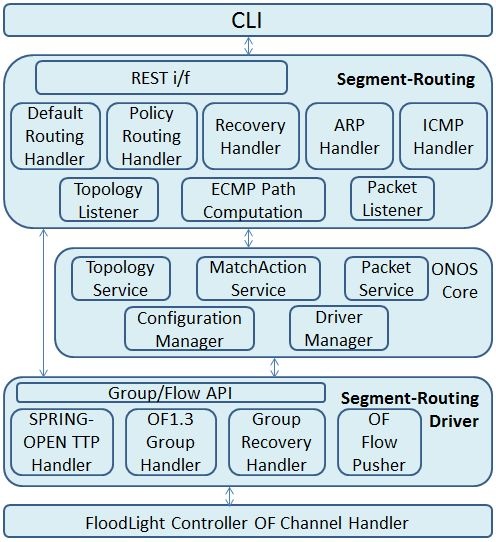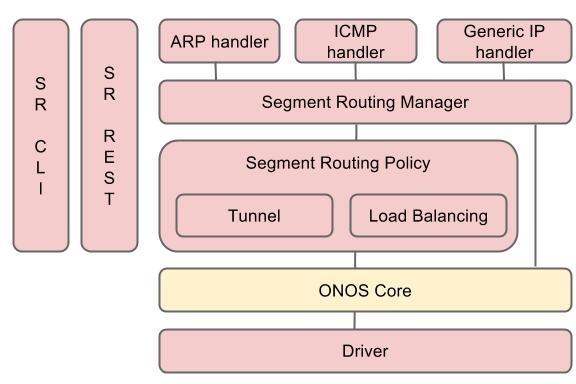Software Modules
The following figure illustrates the Segment Routing application components, and the relationship among those components
The boxes with bold text represents Segment Routing application modules while rest of the components represent ONOS modules that segment routing application depends on. Segment Routing application exposes two external interfaces: REST and CLI.
SPRING-OPEN TTP
It is important for the switch and the controller to have the same (abstract) view of the switch-forwarding pipeline. This view is essentially a Table-Typed-Pipeline (TTP), the framework for which is being developed by the Forwarding Abstractions WG at the ONF. The abstract pipeline used for Segment Routing application is illustrated below, and ‘implicitly’ understood by the switch and controller instances. In addition, the view will be exposed by the OpenFlow switch agent via messages such as Table-Features, Switch-Features and Group-Features. It is intended that the SPRING-OPEN pipeline, while being table-typed, is still generic enough to be implemented by several different vendor ASICs, on different switch platforms. Under-the-hood, vendors can choose different implementation-specific ways to create and maintain the SPRING-OPEN hardware abstraction. NOTE: Table IDs depicted in the picture may vary based on the specific switch implementations.
Highlights of the pipeline shown in above figure are as follows:
- The packet enters through a physical ingress port that is included as metadata that can be matched in some of the pipeline tables. There is an Action-set that is associated with each packet as it traverses the tables in the pipeline. The Segment Routing application will only use Physical OF ports (and not OF Logical ports – see OF spec 1.3.4, sec 4.4)
- The first table (Table 0) is the VLAN flow table. Since the SPRING-OPEN switches need to behave as routers, they should be able to route between VLANs – this routing will be done on the basis of IPv4 addresses, with the VLAN tag (if any) stripped on ingress, and a configured VLAN tag applied (if necessary) on egress. In addition, this table should allow untagged packets.
- The second-table (Table 10) is the Termination MAC flow table which decides if the incoming packet is an IPv4 packet that needs to be routed (in the IPv4 unicast LPM lookup table) or a labeled packet that needs to be forwarded (via the MPLS label lookup table). All packets that do not match either of these cases should be sent to the controller – these include ARP, LLDP and other Ethernet Types.
- The Unicast IPv4 Routing Flow Table (Table 20) is used at ingress and egress of the segment-routed network. In principle they perform the role of LERs, while also routing between connected-subnets. This project will not handle IPv6 routing. Segment routing (or IETF SPRING) does not currently handle IP multicast. Default IPv4 routing using Segment-routing node labels will be performed in this table.
- The MPLS forwarding table (Table 30) is used for single label lookups in transit routers. We will enforce the use of Penultimate Hop Popping (PHP) of segments (labels) network-wide, so that a label pop is not required before an IP lookup in the same router.
- The Policy_ACL table (Table 50) is used for overriding the decisions made in tables 20 and 30, according to policy determined in the controller. This table is typically not ‘typed’ – it can match on multiple fields in the packet header irrespective of networking layer boundaries.
- MPLS related actions include pushing/popping labels, setting label-ids and BoS, and related ttl manipulations. Such actions are written into the Action Set (by tables 20 and 30) using WRITE-ACTIONS. Segment routing requires in some use-cases to push multiple labels at ingress. These are applied using group chaining feature (see OF spec <TODO>).
- Segment routing requires the use of ECMP wherever there are multiple equal-cost paths to the segment-destination. These will be implemented with OF group type ‘select’ for both MPLS and IP packets (i.e at ingress and in transit routers)
- Finally SPRING-OPEN will also use OF ‘Indirect’ groups, for ports on routers that are connected to other routers in the segment-routing domain. These indirect-groups perform standard egress operations on routed packet – setting MAC addresses, as well as TTL/MTU checks. The indirect groups also serve as the ‘bucket’ actions of the ECMP ‘select’ groups.
App & Driver
The following figure describes the architecture of the segment routing application.
- Segment Routing Manager - It computes the shortest ECMP path among all routers and populates all routing rules to IP and MPLS table of the switches. Also, it handles all packets to the application and forwards them to appropriate handlers according to the packet type.
- ARP handler - It handles ARP request and response packets. If the APR request is to the any managed routers, then it generates and sends out the ARP response to the corresponding hosts.
- ICMP handler - It handlers ICMP request to the routers. It generates the ICMP response packet and sends out to the corresponding hosts.
- Generic IP handler - It handles any IP packet. If the destination of the IP packet is hosts within subnets of routers, then it set the forwarding rule to the router and sends out the packet to the corresponding hosts. If MAC address of the host is not known, then it sends out APR request to the subnet using ARP handler.
- Segment Routing Policy - It creates the policy and set the policy rule to ACL table of routers. If it is the tunnel policy, then it creates the tunnel for the policy. NOTE: Load balancing policy is not implemented yet.
Configuration Manager
A Network Config Manager provides network configuration service and filtering service
- Configuration Service: Configuration service handles all network element configuration. For Segment Routing use case, the following network information will be configured through Network Config Manager: Router IP and MAC, Node Segments, Subnets, Filtering policy, etc. The Topology publisher, Driver Manager and Segment Routing Driver modules will use the services provided by Network Config manager while constructing global network view and performing any operations on the network elements as illustrated in below figure. Initially the startup configuration will be file based which can be enhanced to run-time CLI based in later phases.
- Filtering Service: Filtering service provides logic to filter the discovered network entities based on the filtering policy as illustrated in below figure.

